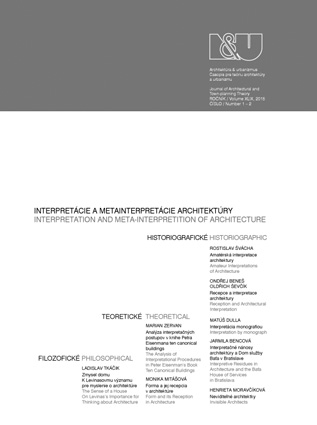FORMA A JEJ RECEPCIA V ARCHITEKTÚRE. Na príklade areálu Vysokej školy poľnohospodárskej v Nitre
FORM AND ITS RECEPTION IN ARCHITECTURE. On the Example of the Agricultural University Campus in Nitra
Author(s): Monika MitášováPublished by: Historický ústav SAV, v. v. i.
Keywords: formal analysis and interpretation; undecidability; university campus; Rudolf Miňovský; Vladimír Dedeček; Nitra
Summary/Abstract: The title of this paper refers to the polarity between formalism and reception aesthetics, emerging in the 1960s yet implicitly formulated much sooner, for example in Czech and Slovak structuralism. The aim of this text is to demonstrate how this polarity shaped the contextual background of architectural thinking in the second half of the 20th century in Slovakia with the specification that despite minor exceptions, it did not develop into individual formal or structural analyses of architecture nor did into research of the social impact and history of reception. Nonetheless, the majority of texts on architecture of that period are dominated by thinking about the form or the social mission/function of architecture, even if the deeper interrelation of both poles in the above-mentioned polarity has never resulted in a new concept of an architectural work or an implicit author or user as formulated by the reception theories of the Konstanz School (Hans Robert Jauss and Wolfgang Iser), Umberto Eco or the ideas on reception aesthetics by František Miko in Slovakia. The Agricultural University Campus (AUC) in the city of Nitra (project by Rudolf Miňovský and Vladimír Dedeček, designed in 1959 – 1961, built in 1960 – 1963) is chosen as an example. Not only do a variety of existing texts tackle this important work from the aspects of both poles of the abovementioned polarity, it is also possible to demonstrate if and to what extent these texts develop the possibilities of the approach chosen by their authors and, at the same time, the consequences of the inconsistent utilization of formal analysis and analysis of reception or social function (e.g., in the case that formal analysis is replaced by a recourse to the genuine model/pattern of applied form, or the study of reception is replaced by the worship of acceptance in international journals). The paper is divided into two parts: the first part is concerned with the form of the AUC and the second with the reception of the AUC’s form. Here, focus is applied to the preliminary analysis of architectural form by confronting the process of formal analysis suggested by the author of this paper with the processes formulated by other authors. The second part tries to offer a typology of reception of the AUC’s form. Both parts are necessary preconditions of a further interpretation of the AUC, which has not yet been done. First, the form of The Agricultural University Campus is explored from the point of view of its spatial distribution, its structure and surfaces – their signifying and non-signifying dimensions forming the base of further formal analysis and interpretation. After the identification of the relations of undecidability, it is possible to assume that it interferes as well with other processes and layers of the AUC. Used in logic (Kurt Gödel), philosophy (Jacques Derrida) and architecture (Peter Eisenman), the term “undecidability” is invoked in this paper as a hypothesis for both the urban and .
Journal: Architektúra & Urbanizmus
- Issue Year: 49/2015
- Issue No: 1-2
- Page Range: 120 - 143
- Page Count: 24

